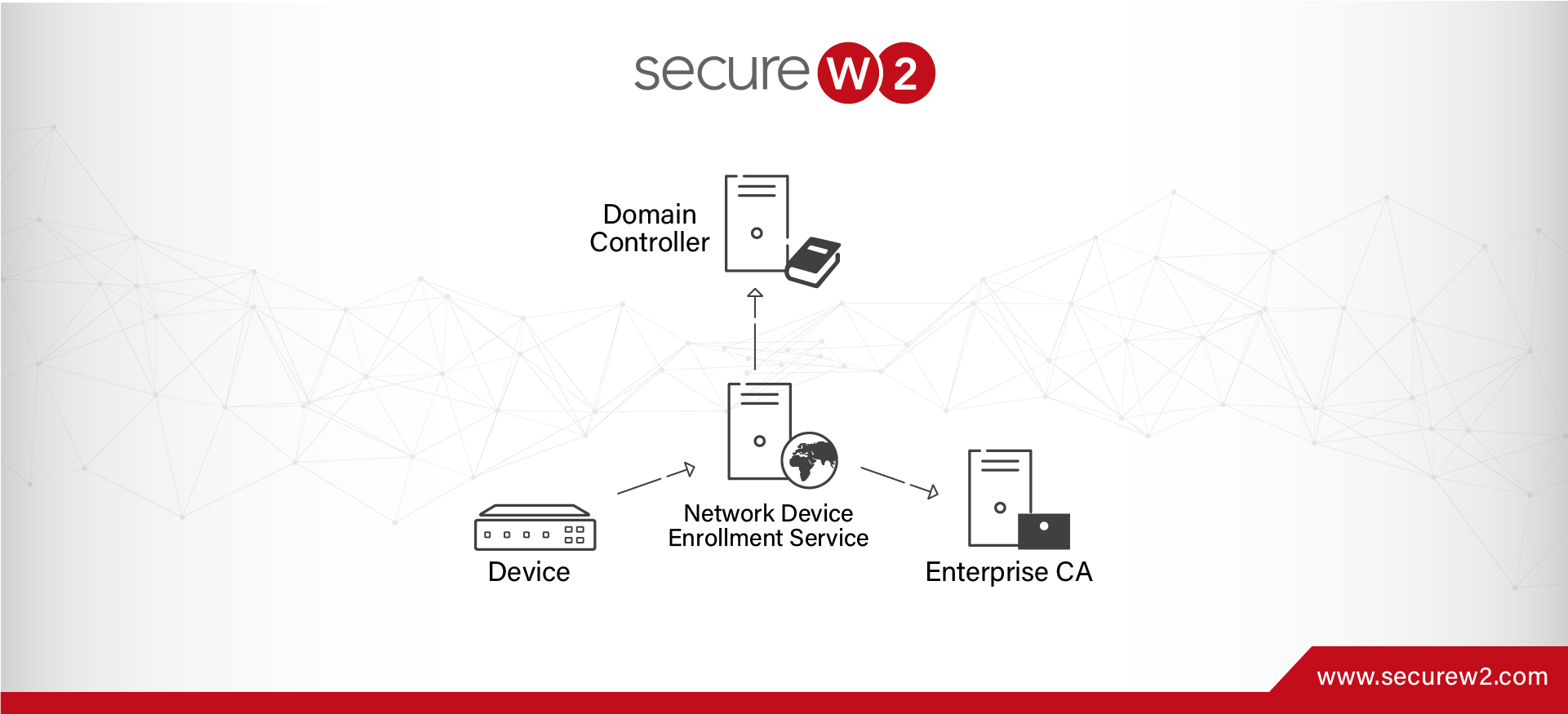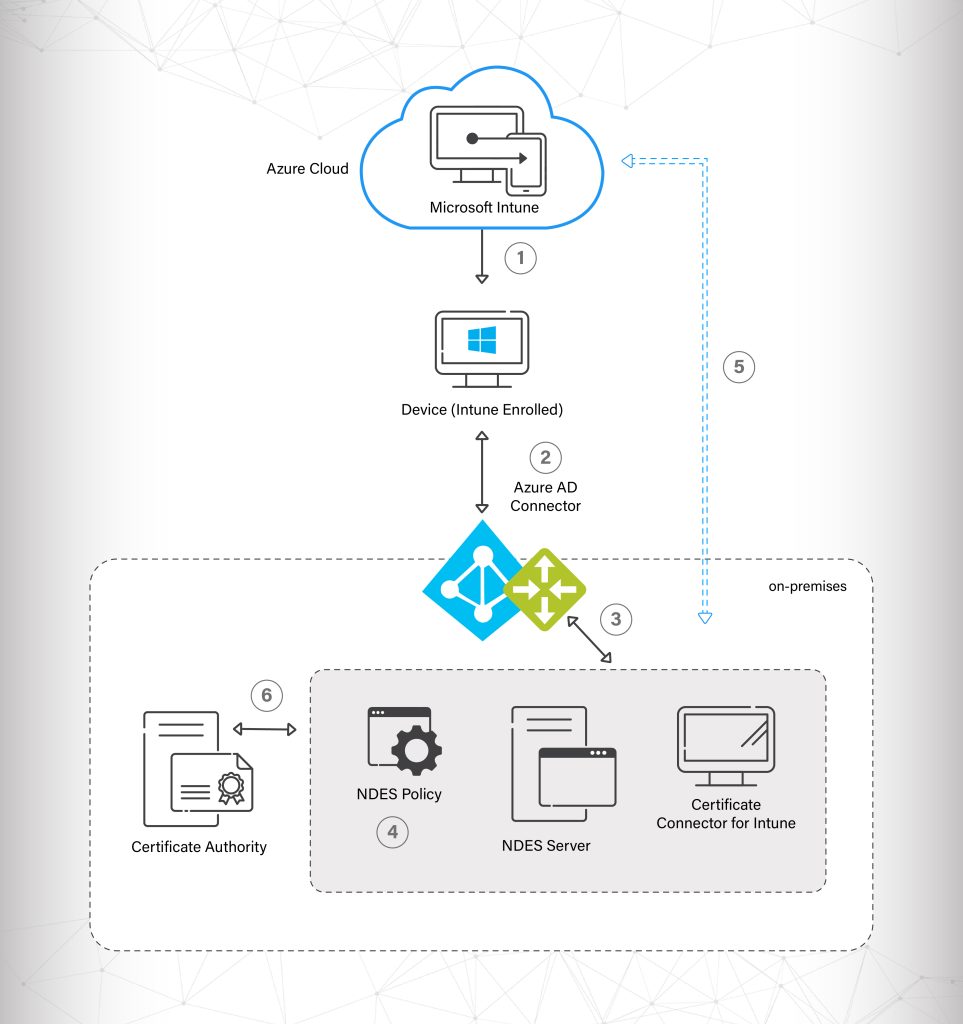In the ever-changing world of cybersecurity, password breaches might have unimaginable consequences for an organization’s finances and reputation. In a recent multi-year intrusion, cybercriminals accessed GoDaddy’s servers, placed malware on its network, and stole portions of its source code. The hackers’ purpose was to infiltrate websites and servers with malware to conduct phishing campaigns, malware distribution, and other nefarious actions.
It is absolutely critical that organizations ensure their security by adopting various passwordless techniques. As a tech giant, Microsoft has always been vocal about its motto of going passwordless by promoting multiple services related to digital certificates. Microsoft NDES as a service is a vital cog in onboarding these certificates.
In this article, we will discuss NDES, its importance in network security, and its benefits for managing devices in an enterprise environment.
What Is Microsoft NDES (Network Device Enrollment Service)?
Microsoft Network Device Enrollment Service (NDES) is an Active Directory Certificate Services (AD CS) feature that is used to issue certificates to devices that do not have other Active Directory (AD) domain credentials from a dedicated certification authority (CA).
NDES is based on Simple Certificate Enrollment Protocol (SCEP) and is used by network admins to handle public key distribution, certificate enrollment, inquiries, and revocations. SCEP is a protocol used for requesting and managing digital certificates in a network environment.
NDES uses AD CS to provide a complete PKI solution for an organization. NDES handles SCEP requests and forwards them to the CA for processing. Once the CA approves the request, the device receives a digital certificate that can be used to authenticate with other devices or services in the network.
How Does NDES Work?
NDES is a technology that enables network devices, such as routers, switches, and firewalls, to obtain and manage digital certificates for authentication and encryption purposes. The NDES server consists of several components, including:
- Enrollment Server — Accepts and processes certificate enrollment requests from network devices
- Policy Module — Verifies enrollment requests and enforces policy requirements, such as certificate expiration and usage
- Certificate Authority (CA) — Issues digital certificates to other network devices based on enrollment requests and policy requirements
- Database — Stores enrollment and certificate information for the NDES server
- Network Devices — Devices that request and use digital certificates for authentication and encryption
NDES, at its core, performs the following functions:
- Generates one-time device enrollment passwords
- Transmits device enrollment requests to the CA
- Collects enrolled certificates from the CA and send them to the device
The flowchart of the NDES server would typically involve the network device sending an enrollment request to the NDES server, which the Enrollment Server and Policy Module process. If the request meets policy requirements, the CA issues a digital certificate to the network device stored in the database. The network device can then use the certificate for authentication and encryption purposes.
Benefits of Using NDES
NDES is essential because it provides a secure and automated way for network devices to obtain digital certificates necessary for authentication and encryption. Digital certificates are used to verify the identity of a device, establish secure communication channels, and encrypt data transmitted over the network.
Without NDES, managing digital certificates for a large number of devices in an enterprise environment can be a daunting and time-consuming task. NDES simplifies this process by automating the enrollment and management of digital certificates, saving IT administrators significant time and resources.
Using NDES has several other benefits, including:
- Automated certificate enrollment: NDES automates the process of requesting and obtaining digital certificates, reducing IT administrators’ workload and ensuring that all devices are enrolled with the correct certificates.
- Enhanced security: NDES provides a secure way for devices to obtain digital certificates necessary for secure communication and authentication in a network environment.
- Centralized management: NDES can be integrated with Microsoft Active Directory Certificate Services, which provides centralized management of digital certificates for an entire organization.
- Scalability: NDES is designed to handle large-scale network device deployments, making it an ideal solution for managing digital certificates in an enterprise environment.
- Compatibility: NDES is compatible with a wide range of network devices and operating systems, which makes it a flexible solution that can be customized to meet the needs of different organizations.
Is NDES Secure?
Yes, NDES is a secure solution for managing digital certificates in a network environment. NDES uses the SCEP protocol to securely request and obtain digital certificates from a Certificate or Registration Authority. NDES is designed to handle large-scale deployments of network devices and can be integrated with Microsoft Active Directory Certificate Services for centralized management of digital certificates.
NDES is also compatible with a wide range of network devices and operating systems, which makes it a flexible solution that can be customized to meet the needs of different organizations. Additionally, NDES can be configured to enforce strict security policies and access controls to ensure that only authorized devices can enroll for digital certificates.
Is NDES Cloud Compatible?
Yes, NDES is cloud compatible and can be used to manage digital certificates for devices that are deployed in cloud environments. NDES can be integrated with cloud-based certificate authorities and can be configured to work with virtual machines and other cloud-based devices.
By using NDES in a cloud environment, organizations can benefit from the same level of security and scalability as they would with an on-premises deployment. NDES can also be configured to work with hybrid cloud environments, where some devices are deployed on-premises, and others are deployed in the cloud.
Does NDES Require an Active Directory (AD)?
While NDES can be integrated with Microsoft Active Directory Certificate Services for centralized management of digital certificates, it does not require Active Directory (AD) to function. NDES can be deployed in standalone mode, where it serves as a standalone server that can process SCEP requests and digital issue certificates.
However, integrating NDES with AD provides additional benefits, such as simplified management of digital certificates and enhanced security through the use of AD security policies and access controls.
Simple Certificate Enrollment Protocol (SCEP)
SCEP (Simple Certificate Enrollment Protocol) is a protocol that simplifies the process of configuring the integration between MDMs and the Certificate Authority (CA) for successful certificate issuance by automatically enrolling MDMs with certificates without any end-user interaction.
SCEP provides a simple and efficient way for devices to request and receive digital certificates without the need for manual configuration or complex setup. This is done using a challenge-response mechanism, where the device sends a certificate request to the CA, and the CA responds with a challenge the device must complete to prove its identity. Once the device completes the challenge, the CA issues the certificate to the device.
SCEP ensures the data and systems are secure, allowing access to only authorized devices for sensitive information.
Next, we’ll look into the relationship between SCEP and NDES and how to use it to maximize your organization’s security.
NDES vs. SCEP
NDES and SCEP are closely related technologies, but they serve different purposes. SCEP is a protocol used for requesting and managing digital certificates in a network environment. NDES is a software component of the Microsoft Windows server that allows network devices to enroll with a PKI and obtain digital certificates using SCEP.
SCEP can be used with a variety of PKI solutions, while NDES is specifically designed to work with Microsoft Active Directory Certificate Services. NDES provides additional benefits, such as automated certificate enrollment, enhanced security, centralized management, scalability, and compatibility with a wide range of network devices and operating systems. By using NDES, organizations can simplify the process of managing digital certificates, enhance security, and improve the scalability of their network infrastructure.
In a nutshell, SCEP is a protocol used to issue and manage digital certificates, and NDES is a component of Microsoft’s AD CS that uses SCEP to issue certificates to devices in a network. Together, they provide a simple and efficient way for devices to obtain and manage digital certificates, which is important for ensuring the security and integrity of networked systems and data.
Although the combination of SCEP with NDES sounds very effective in ensuring your organization’s security, onboarding to digital certificates is an art only some admins are capable of. There are complexities involved with many vendors, and some are also tougher on the budget to begin with. But to ease this burden, we at SecureW2 are committed to reducing the industry’s dependency on passwords.
Easy Device Onboarding for Certificates With SecureW2
As we have just seen, certificate management can be cumbersome because it involves managing certificates for various purposes, such as SSL certificates for websites, code signing certificates for software, and identity certificates for individuals or devices. Keeping track of all these certificates, ensuring they are valid and not expired, and renewing them when necessary can be challenging and time-consuming.
We at SecureW2 simplify this process by automating many tasks in managing digital certificates. This includes automatic certificate enrollment and renewal and a user-friendly interface for managing certificates and viewing their status.
SecureW2 also provides additional security features, such as two-factor authentication, customizing certificate templates, and certificate revocation, which help to ensure that only authorized devices and users can access sensitive data and systems.
With SecureW2, administrators can easily issue and manage digital certificates for devices and users, eliminating the need for manual configuration and reducing the risk of errors. We can integrate seamlessly with your existing network infrastructure, allowing admins to deploy certificates quickly and efficiently. We support a range of industry-standard protocols, including EAP-TLS, which enables administrators to implement NDES with minimal disruption.
We also provide a user-friendly interface for managing NDES via the SCEP protocol by enabling admins to issue, revoke, and manage certificates, set policies, and configure settings from a centralized console. We believe in constantly upgrading our services for the benefit of our customers. If you’re interested in expanding your organization’s cybersecurity horizons, check out our pricing to learn more.




